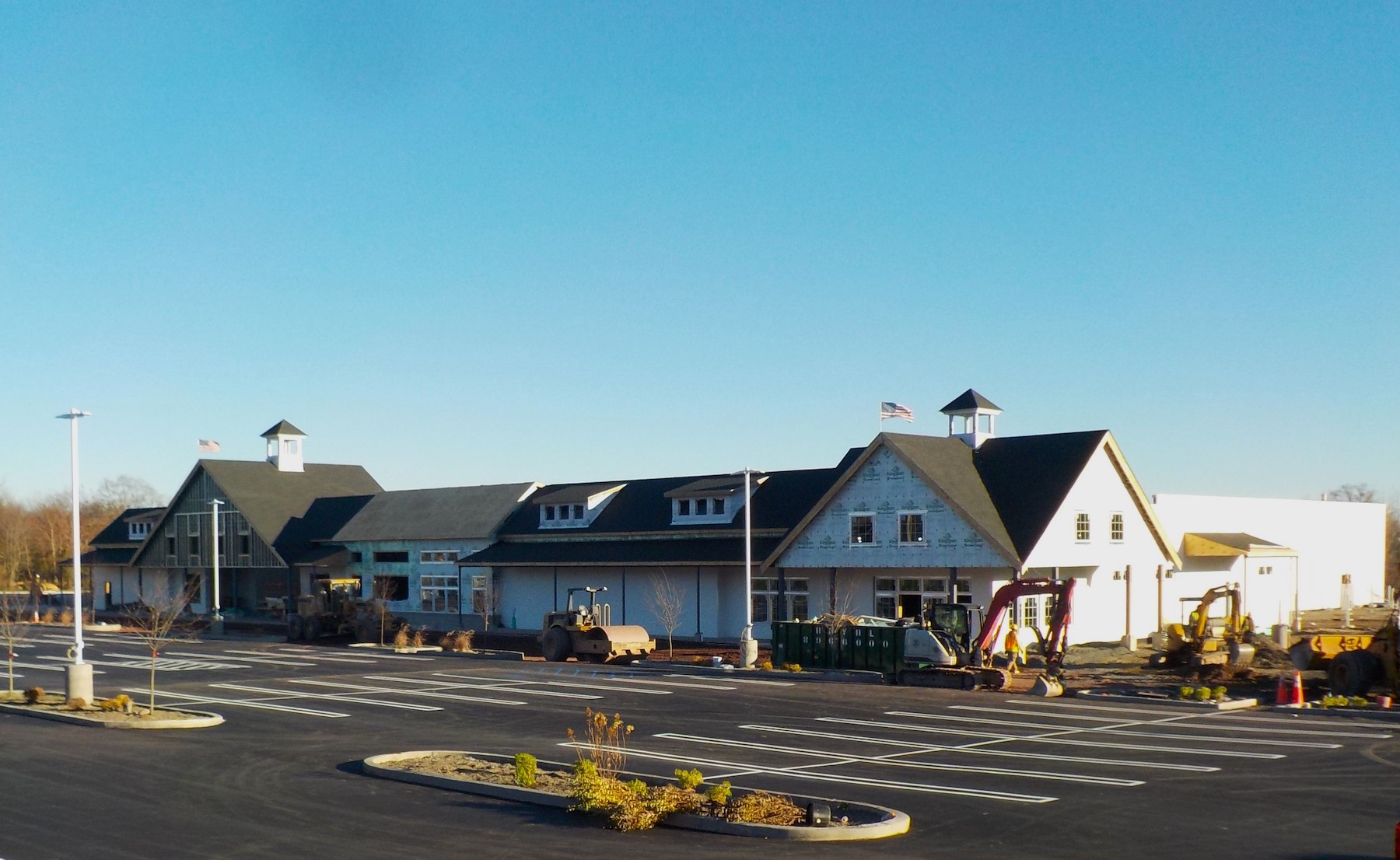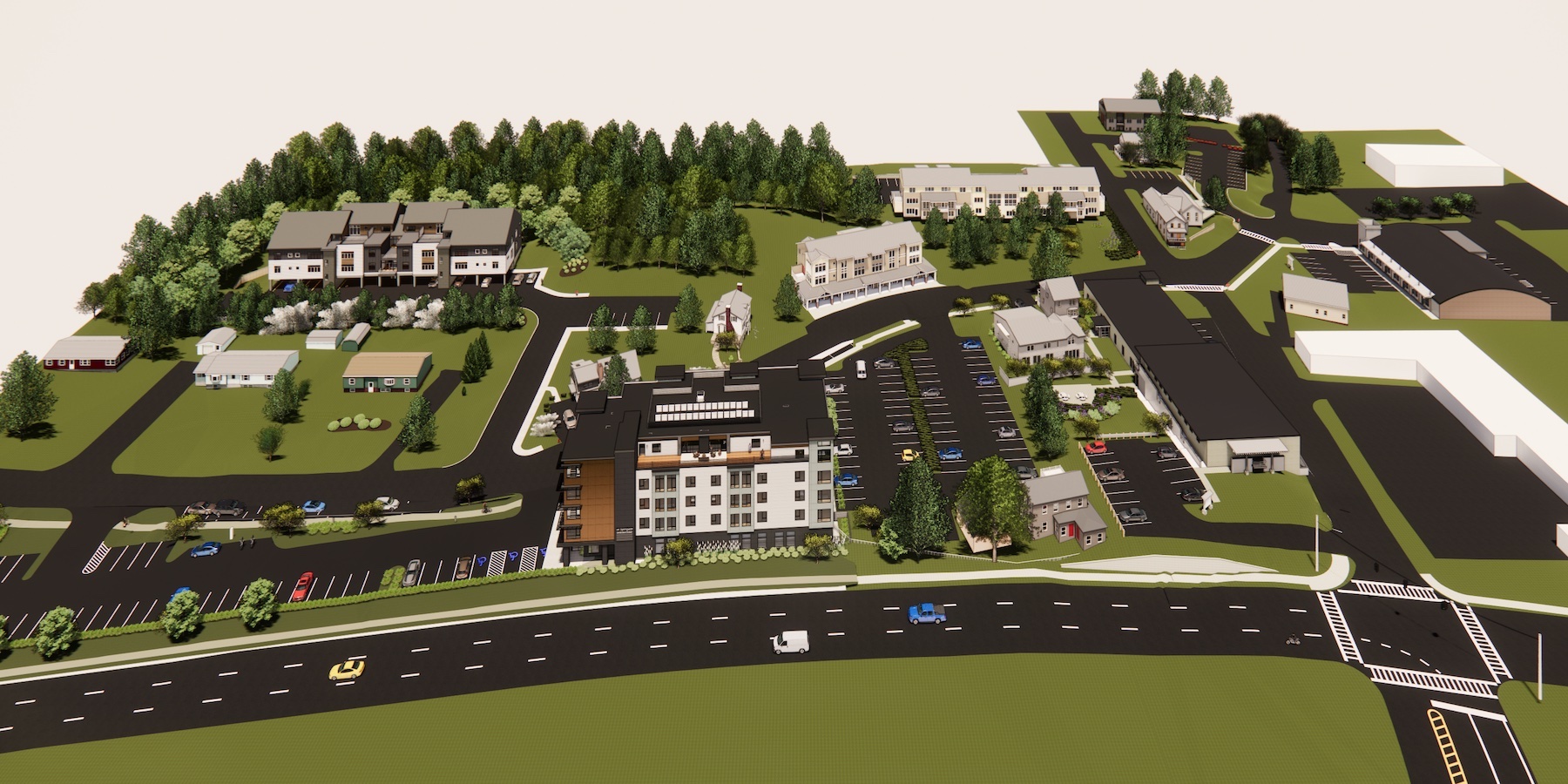Tinkelman Architecture is preparing to break ground on a five-story building, located at the Van Wagner Place mixed-use campus in Poughkeepsie, N.Y., that will have 28 luxury apartments, commercial space on the first floor with an indoor pool that will be used by the British Swim School franchise, and a top-floor community space that opens onto a roof deck.
Tinkelman Companies, the firm’s development and property management arm, has been involved with Van Wagner Place for a decade, starting with the renovation and repurposing of four derelict buildings. The campus is now home to offices, shops, and other businesses, as well as the firm’s headquarters inside a former warehouse in Poughkeepsie’s Arlington business district.
In fact, over the 30 years it has been serving New York’s Hudson Valley, Tinkelman Architecture has been the designer on more than 100 projects within that market. Its fingerprints can be found on local banks, wineries, restaurants, retail stores, historic structures and parks, to say nothing of the numerous residential projects it has engaged.
“We like doing a lot of housing,” says Steven Tinkelman, a Poughkeepsie native and life-long Hudson Valley resident, who founded Tinkelman Architecture in 1993. Over the years, his work has contributed to this market becoming, in his words, “more sophisticated, regional, cosmopolitan.”
Tinkelman Architecture generates between $1 million and $2 million per year in revenue from its design work, and double that when development and property management are included.
Wide-ranging projects
A graduate of Cooper Union and a modernist by training, Tinkelman also acknowledges the aesthetic influence of rustic summer camping as a child. “So there’s a blending of modern tradition with sticks and twigs,” he quips.
His 14-person firm has no signature architectural style, and he is fine with that agnostic approach because he believes it opens portals to pursue a diversity of projects in a market where, he says, other small design firms have come and gone. (While the market’s growth has attracted more civil engineering and construction firms, Tinkelman observes that there’s still a need for structural and mechanical engineers.)
One of Tinkelman Architecture’s better-known infrastructure projects was the design for the Upper Landing Park in Poughkeepsie, which sits under a 1.28-mile walkway across the Hudson River, which opened in 2009. The park includes an elevator to the walkway, which is the longest elevated pedestrian bridge in the world.

Among the projects Tinkelman Architecture is currently working on are a 56-unit residential building in Fishkill, N.Y., with 5,000 sf of commercial space; and a 40- to 45-unit residential building in the urban part of Poughkeepsie that will overlook its train station. The latter project, says Tinkelman, includes the restoration of an 1860s-era building that will be used by an arts organization.
The firm has also designed a four-story, 20-unit building called The Westerly, and was recently retained by New York’s Dutchess County to design a campus for homeless housing.
Seeking expansion opportunities
Among Tinkleman’s ongoing clients is the retailer Adams Fairacre Farms, whose stores mingle a country feeling with contemporary design. Tinkelman designed this retailer’s outlets in Newburgh and Wappinger, N.Y., and the expansion of its Poughkeepsie location. The firm is currently working on Adams Faircare Farms’ 56,643-sf store in Middletown, N.Y., which is under construction, and when completed next year will include a 2,905-sf tropical greenhouse and 6,048-sf seasonal greenhouse.

Tinkleman Architecture is looking to expand beyond the region with which it has become synonymous. It currently has active projects in Ulster and Orange counties (the latter is where the Middletown store will be located), and has been looking for opportunities in Westchester County and nearby Connecticut. But Tinkelman, who lives with his wife Rachel in Pleasant Valley, N.Y., says he still gets a kick from seeing local residents course through buildings and spaces in the mid-Hudson Valley his firm helped create.
Related Stories
Building Technology | Jun 18, 2024
Could ‘smart’ building facades heat and cool buildings?
A promising research project looks at the possibilities for thermoelectric systems to thermally condition buildings, writes Mahsa Farid Mohajer, Sustainable Building Analyst with Stantec.
University Buildings | Jun 18, 2024
UC Riverside’s new School of Medicine building supports team-based learning, showcases passive design strategies
The University of California, Riverside, School of Medicine has opened the 94,576-sf, five-floor Education Building II (EDII). Created by the design-build team of CO Architects and Hensel Phelps, the medical school’s new home supports team-based student learning, offers social spaces, and provides departmental offices for faculty and staff.
Healthcare Facilities | Jun 18, 2024
A healthcare simulation technology consultant can save time, money, and headaches
As the demand for skilled healthcare professionals continues to rise, healthcare simulation is playing an increasingly vital role in the skill development, compliance, and continuing education of the clinical workforce.
Mass Timber | Jun 17, 2024
British Columbia hospital features mass timber community hall
The Cowichan District Hospital Replacement Project in Duncan, British Columbia, features an expansive community hall featuring mass timber construction. The hall, designed to promote social interaction and connection to give patients, families, and staff a warm and welcoming environment, connects a Diagnostic and Treatment (“D&T”) Block and Inpatient Tower.
Concrete Technology | Jun 17, 2024
MIT researchers are working on a way to use concrete as an electric battery
Researchers at MIT have developed a concrete mixture that can store electrical energy. The researchers say the mixture of water, cement, and carbon black could be used for building foundations and street paving.
Codes and Standards | Jun 17, 2024
Federal government releases national definition of a zero emissions building
The U.S. Department of Energy has released a new national definition of a zero emissions building. The definition is intended to provide industry guidance to support new and existing commercial and residential buildings to move towards zero emissions across the entire building sector, DOE says.
Multifamily Housing | Jun 14, 2024
AEC inspections are the key to financially viable office to residential adaptive reuse projects
About a year ago our industry was abuzz with an idea that seemed like a one-shot miracle cure for both the shockingly high rate of office vacancies and the worsening housing shortage. The seemingly simple idea of converting empty office buildings to multifamily residential seemed like an easy and elegant solution. However, in the intervening months we’ve seen only a handful of these conversions, despite near universal enthusiasm for the concept.
Healthcare Facilities | Jun 13, 2024
Top 10 trends in the hospital facilities market
BD+C evaluated more than a dozen of the nation's most prominent hospital construction projects to identify trends that are driving hospital design and construction in the $67 billion healthcare sector. Here’s what we found.
Adaptive Reuse | Jun 13, 2024
4 ways to transform old buildings into modern assets
As cities grow, their office inventories remain largely stagnant. Yet despite changes to the market—including the impact of hybrid work—opportunities still exist. Enter: “Midlife Metamorphosis.”
Affordable Housing | Jun 12, 2024
Studio Libeskind designs 190 affordable housing apartments for seniors
In Brooklyn, New York, the recently opened Atrium at Sumner offers 132,418 sf of affordable housing for seniors. The $132 million project includes 190 apartments—132 of them available to senior households earning below or at 50% of the area median income and 57 units available to formerly homeless seniors.

















